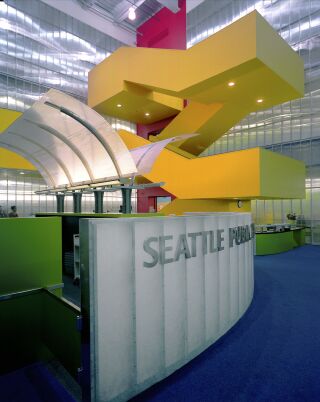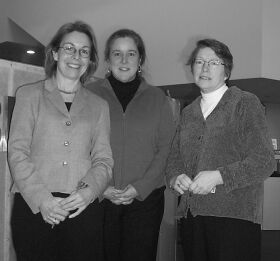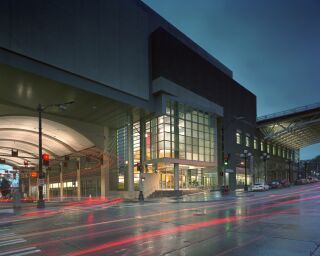|
Subscribe / Renew |
|
|
Contact Us |
|
| ► Subscribe to our Free Weekly Newsletter | |
| home | Welcome, sign in or click here to subscribe. | login |
Architecture & Engineering
| |
February 6, 2002
Temporary library makes a lasting impression
Special to the Journal

Photos by Fred Housel
The library’s atrium, a panoply of color behind glass, is the visual core of the project. At the third level, the stacks reach all the way back to Ninth Avenue. The lower two levels, to the right of the atrium, enclose retail and center-related activities.
|
Between the gray lid and skybridges of the expanded Washington State Trade and Convention Center, the corner of Eighth and Pike glows like the lights of someone who is clearly home.
The downtown branch of the Central Library Library has moved in -- at least for awhile. During the two years it takes to build its new, permanent home at Fourth and Spring, the library is a welcoming fixture amid the ebb and flow of big events.
The temporary address of the library will become the permanent home of MOHAI, the Museum of History and Industry.
Jane Hendricks, an architect at LMN who has been guiding both the museum and the temporary library projects, was not put off by the idea of temporary design. "You put that word ‘temporary’ on a project and it flies under a lot of peoples' radar," she said.

Photo by Clair Enlow
Jill Jean, the library’s central services director with architect Jane Hendricks and Jody Fenton, manager of arts, recreation and literature departments for the library.
|
Even great architecture can be temporary, she said, and Hendricks has some favorite examples: the Barcelona Pavilion, the panels for Catherine deMedici’s entry into Paris, Frank Gehry’s installation for a Constructivist exhibit in Los Angeles and the network of pink tubing and scaffolding at the 1984 Olympics, also in Los Angeles.
And there it is at the corner of Eighth and Pike: imagination in a box. Blocks of color and sculptural forms fill a three-story atrium behind the doors and the glass walls. It’s so much fun, it doesn’t look like a city facility.
Temporary architecture is freeing, said Hendricks.
"You don’t have to have a tasteful, timeless color scheme." Instead, she said, her clients chose mango, lime and sunset red, with a jolt of blue thunder. The sunny vacation scheme was such a success with the staff that they handed out a tropical fruit sculpture at an awards program and draped leis over shoulders.
Accessible in every way, it combines the qualities of an institutional mission and retail service, with a touch of entertainment mixed in. People have walked in the doors asking if they have arrived at the Experience Music Project, according to Jody Fenton, manager of arts, recreation and literature departments.
| JURY COMMENTS |
|
"I applaud the library and architect for creating a temporary environment that is fun and inviting while respecting the need to keep the construction budget at a minimum. Hopefully this space will become part of the beaten path of Seattle, and assist future tenants -- especially MOHAI -- in getting 'walk-in visitors.'"
"An unusual program will give this space two lives, first acting as the main library for the next several years, then later converting to museum use. The design of the lobby is a bold street front advertisement for these worthy public uses, intentionally bright and visible in the massive convention center complex." "I like the bold use of glass, light and color to reach out and draw in patrons from the rather dark street under the convention center sky bridge. One has the immediate sense of the library as fun and exciting as well as the expectation of much more to come." "Shoehorned into a tight storefront location along a very busy street, the library projects a bold, inviting façade to the street. The creative use of industrial materials and strong colors contrasts well with the somewhat restrained nature of the building exterior. As a temporary installation, this design packs a lot of punch!" |
The atrium floor plan, with its low, curving partitions, diagrams the flow of library patrons as they pass from doors to desks to stair. From a linear pedestal at the center, two curving mesh panels arc in opposite directions, opening like a book over the circulation desk. The stairway itself dominates the interior space, wrapped in bright yellow wall board and spiraling three stories to the top.
The composition and the atrium itself are wrapped in shimmering, translucent panels of polycarbonate plastic. To orient visitors, staff members can simply point to their destination.
Staff and administrative areas are tucked into spaces behind the atrium, while most of the accessible stacks of the library are housed on the vast third floor, which extends to the corner of Ninth and Pike. Seating areas line the perimeter corner, a peaceful perch over a lively intersection, with great views of the draping greenery that decorates the original convention center. Closed stacks are located in a basement directly below the atrium, and a basement mezzanine houses technical services.
Behind the walls of the atrium, help desks welcome the visitor, and rows of book stacks extend to the distant walls. A huge collage of a dragon made by Meng Huang, courtesy of Seattle Arts Commission, hangs overhead. Substantial wedges of mango-colored blocks divide sections of the front desks in every department. These constructions are a kind of "universal joint," according to Hendricks, that ties the sections of the library together and helps to unify the floors.
In place of metal ducting hanging over the large space, the architect specified the use of special fabric envelopes. This system for distributing hot and cold air is most often used for swimming pools, because they do not corrode. On every floor, the expanding contracting lime-colored fabric ducts make a bright and dynamic counterpoint to the gray stacks.
Designing and moving to a new building often goes hand-in-hand with the redesign of an organization, and the Seattle Public Library is no exception.
The staff picked up and put itself back together, along with all of the books, in a new order. Actually, the new order is built around a more pure expression of the time-tested Dewey decimal system. The "straight Dewey run" is an impossible dream for some librarians -- a paradise where any book can be quickly plucked from the stacks and returned just as easily. Self service for library patrons is entirely possible. The downtown library is on its way.
There is a countervailing trend among libraries: that of "collections," or books that are sequestered in separate subject areas. These areas are managed by individual librarians and linked to constituent groups and fundraising efforts. Some libraries, such as San Francisco’s new downtown library, are designed around these subject areas.
The old Central Library was a hybrid of these two extremes, with some continuous runs and some separate subject areas such as business, humanities and arts. A search for a single book could lead through several parts of the library, requiring assistance all along the way.
"Librarians are notorious for arranging things according to their own ease of use," said Fenton.
In planning the new library on Fourth Avenue, decisions about space become decisions about the future. For the first time in decades, the library began a process of deeply sorting its collections, unloading materials on other libraries and institutions, and selling some. The first of two moves, to the temporary site, imposed its own limits on collection size.

The temporary downtown Seattle Public Library is a beacon on Pike Street. |
The old building had 206,000 square feet and the new one, now under construction, will have 363,000 square feet. But in its temporary home the library must squeeze into 127,000 square feet.
The housecleaning effort left the library with around 800,000 volumes, according to library central services director Jill Jean. Fewer than half are now housed in the temporary facility. The other half is divided between a storage facility on Queen Anne and a warehouse on Airport Way.
As the staff winnowed through the collection, they were able to look at the library in its entirety, with its redundancies, thin areas and gaps in coverage. After moving into its new home, the library’s collection will grow to a healthy one million books.
Bringing the library staff into the design process was the most important part of the task. In an exercise devised by the library’s space planners, RPG Partnership of Vancouver, staff members were each given a piece of paper representing the square footage then occupied by particular area in the downtown library. Then, standing around a similar-scaled model of the temporary facility, they tried to fit the pieces of paper onto the floor plates. Working busily with scissors, they succeeded. Together, they helped to make decisions about their own downsizing process as their relative positions in the new facility emerged.
| Project Team |
|
Project: Temporary Central Library 800 Pike St. Client: Seattle Public Library Architect: LMN Project type: Interior build-out Project size: 122,000 square feet Project cost: $6.5 million Date of completion: July 2001 Structural engineer: Skilling Ward Magnusson Barkshire Mechanical engineer: CDi Electrical engineer: Sparling Cost estimator: CPD Estimating General contractor: Berschauer Phillips Construction Shell & core contractor: Kiewit Construction Co. |
Now the staff has its straight Dewey run. At the temporary downtown library, it is possible to see the future. It’s a cultivated field of books where the collection can grow without upsetting the pattern or requiring millions of dollars in changes. The permanent downtown library, designed by OMA/LMN, has the expandable Dewey run at the very center of the concept.
In the meantime, staff and patrons are getting to know what it’s like to freely move between offices, departments and the stacks. The fun of temporary design continues in the elevator, where the ride between floors is a little like a swim. The effect of the watery blue paint is heightened with a rippling pattern in the Formica.
"The staff is so happy, we just feel like we’ve made out like bandits," said Jean.
The Project of the Month feature is sponsored by the Daily Journal of Commerce and the Seattle chapter of the American Institute of Architects. Design categories include all types of construction, with the exception of single-family houses. Projects are selected by a panel that includes architects, other members of the arts and design communities and representatives of client groups. The Project of the Month for February, the temporary Central Library, by LMN Architects, was selected with the assistance of architects Peter Hockaday, Marilyn Brockman and Bill Fuller; and developer Val Thomas. For more information about submitting projects for possible feature articles, contact Peter Sackett at AIA Seattle, (206) 448-4938, or psackett@aiaseattle.org.
Clair Enlow can be reached by e-mail at clair@clairenlow.com.
Previous columns:
- Signature identity on a human scale, 01-09-2002
- Gates Hall uses the past to create a better future, 12-05-2001
- A study in flexibility, 11-07-2001
- Southeast Tower cures several ills at Swedish, 10-03-2001
- Growing Vine Street takes root at 81 Vine, 09-05-2001
- A new model for affordable housing, 08-01-2001
- Swimming in good architecture, 07-05-2001
- High-tech medicine, spiritual space, 05-02-2001


